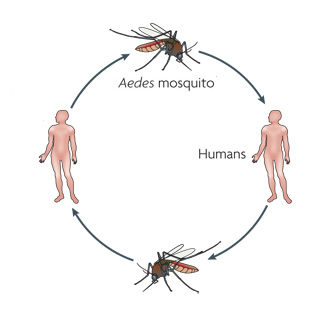Dengue transmission
Keywords
Flag Inappropriate
Delete Content

Dengue transmission
The dengue virus is spread through a human-to-mosquito-to-human cycle of transmission.
This image is linked to the following Scitable pages:
The dengue virus is spread through a human-to-mosquito-to-human cycle of transmission, with the mosquito <i>Aedes aegypti</i> as the primary vector. These mosquitoes live near humans in tropical and subtropical regions of the world. Female <i>Aedes aegypti</i> become dengue vectors after feeding on the blood of a person infected with the dengue virus. Infected mosquitoes continue to transmit dengue with each blood meal for the rest of their lives. <i>Aedes aegypti</i> have a complex life cycle that includes aquatic and terrestrial stages. These mosquitoes lay their eggs inside containers, and new <i>Aedes aegypti</i> hatch when the containers are filled with water. Dengue poses the greatest risk in highly populated regions with rainy seasons where there are large populations of <i>Aedes aegypti</i> with a high degree of contact between the mosquitoes and humans.





















Comments
CloseComments
Please Post Your Comment